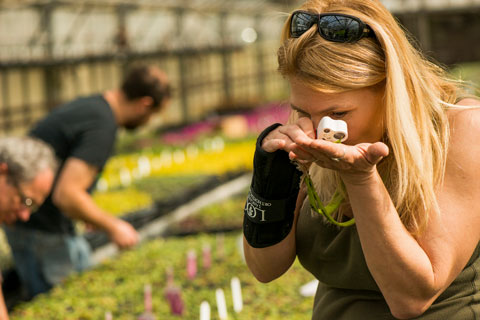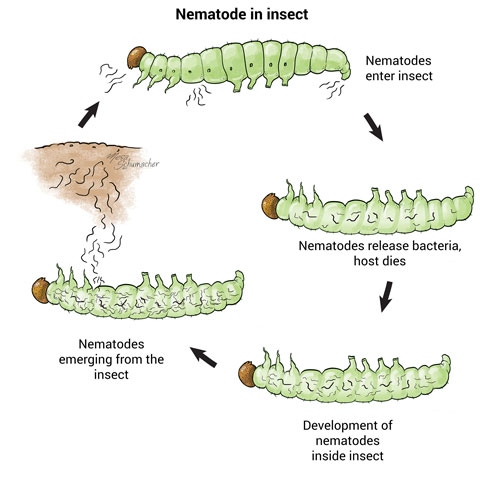12/1/2024
Biosolutions for Propagators
Jeremy Webber

In propagation, plants germinating their first roots are plants at their most vulnerable. They’re slender pieces of tissue, so small problems can knock them back with a bigger impact than expected. As they begin their growth, this is the time crops benefit from a custom bioprogram so they can develop into quality, viable plugs by shipping time.
Pictured: Having an internal champion for your bioprogram is mission critical. Operations with consistent success year after year have someone who’s behind the wheel and taking ownership, like Laura Buck, IPM Manager at Creek Hill Nursery. External support is key, but internal makes all the difference.
A key point to remember is that any chemical applied to a plant can be stressful. In an ideal setup, chemical pesticides should be applied as infrequently as possible. Even water, when applied out of balance, stresses young plants. They become more strongly established when left to grow naturally on their own, but in commercial production they’re going to need help with pest control. By using biological and microbiological controls as part of a structured bioprogram, a lot of the stress moves off plants and onto predators.
It’s important to get biological pest control advice from people who know the crops well because the best bioprogram is one that’s tailored to each crop’s unique needs. A grower-first strategist selects the right product because they know how a crop should look at each stage of its growth, as well as the various pitfalls to avoid. Of course, a plan can change when necessary to address any fluctuation in the pest problem or environment.
Stock plants: At the beginning
Although stock plants are mostly maintained by massive offshore farms, this isn’t often the case for material outside the high-volume products. It’s still common for growers to maintain their own stock plants for unique or hard-to-obtain material, especially for plants with a perennial nature, hardy or otherwise.
It’s surprising, but the simple act of measuring cutting output is a useful way of gauging the effectiveness of a bioprogram. Switching to predatory insects instead of chemistry usually results in more cuttings, which equals more revenues in the end. Plants put more of their energy into filling out their vegetative growth rather than fighting off the effects of the chemical sprays. That extra growth spurt can be significant. It’s common to see cutting yields increase by 25% to 35% or even greater when measured year over year.
Wet stage: Rooting
Propagation crops from seeds or cuttings are in their most fragile state while subjected to the extremely humid conditions required for rooting. Moisture brings fungus gnats, shore flies and fungal diseases. These can scar the primary root, stunting the plant and interfering with crop uniformity.
Fortunately, beneficial nematodes also thrive in wet conditions, and just like the bacterial and fungal pathogens propagators are trying to prevent, beneficial bacteria and fungi work well here, too. Using them instead of chemical controls allows rooted material to stay focused on building strong plants.
Fungus gnats are especially harmful to plants in this stage, as they can effectively eat newly generating roots as quickly as the little propagule can create them. Controlling this problem in propagation is easy, however, and can be done with nematodes; the key is to start early and apply regularly through the rooting phase. Nematodes are used here specifically, as soil-dwelling predatory mites typically have a rough time in the initial phases of propagation. They don’t like swimming and waterlogged media is a bad environment for them to be successful. Stick with nematodes for the first few wet weeks of the crop for best results.
 Pictured: Nematodes are just delivery vehicles for the symbiotic bacteria they carry inside them. Once applied to the target, they release the bacteria and that does the job. Even for a bug guy this can be a little creepy.
Pictured: Nematodes are just delivery vehicles for the symbiotic bacteria they carry inside them. Once applied to the target, they release the bacteria and that does the job. Even for a bug guy this can be a little creepy.
Among nematodes, two species dominate: Steinernema feltiae and Steinernema carpocapsae. While S. feltiae has the lion’s share of the market, S. carpocapsae is quickly gaining ground. It’s far more active in warmer media (anything north of 85F/29C) and also goes after many more pests, caterpillars and shore flies specifically. Most propagators just run S. carpocapsae weekly, year-round at this point. It costs more, but they get a better result for the money spent.
Biological controls such as beneficial bacteria and fungi (Bacillus spp. and Trichoderma, for example) have an impact on seed germination, too. When that initial root emerges from the seed, the beneficial fungi colonize the surface as they rapidly expand. They begin protecting the plant right away from the attack of any pathogens that might be in the rooting media.
Additionally, many of these organisms are growth promotion agents. It’s common for Bacillus spp. to solubilize phosphorus and to chelate micronutrients in a truly symbiotic relationship with the plant. Beneficial bacteria and fungi are there to feed on the sugars that the plant’s root system exudes during growth, so the happier and more protected the plant is the better they do as well.
Dry stage: Bulking up
After the inputs have rooted sufficiently, the environment changes to encourage the tiny propagule to bulk up vegetatively. Air dries out to a microenvironment better suited for the plant’s quick growth. In all cases, the humidity drops a lot, but each crop is handled by each grower and facility a little differently at this stage and the bioprogram strategy adjusts accordingly.
As a rough rule, focus turns to predatory mites to address pests like spider mites, thrips and broad mite. Multiple biological and conventional options exist for other common offenders like aphids and whiteflies. This is a key point to remember: A good bioprogram should look at reducing or eliminating repeated chemical applications to the crop.
That doesn’t mean that they’re no longer on the table. It’s quite common to go after three or four pests biologically, but to then fall back on sporadic applications of Mainspring GNL, Altus or Rycar (for example) to treat for aphids as they pop up in the future. All three of these newer insecticides are generally safe for use with most beneficial agents being applied in propagation systems.
Mass trapping is key in both wet and dry stages due to the ever-present nature of fungus gnats and shore flies. It not only serves as an early warning device to identify growing hot spots, but certain colors effectively trap adult insects as they fly overhead. If this is a new concept, imagine how many pests are killed with a single monitoring card in a week and then extrapolate out to how many would be eliminated by putting in 100 times that number. It’s cheap, simple and highly effective on most of the adult, winged forms of pests that are worrisome, even if it can be rather ugly at times.
Continued applications of beneficial bacteria are highly effective in this stage. Trichoderma or other beneficial fungi applications from when the crop was rooting typically have long shelf lives, upwards of 90 days if they’re properly introduced and established. This means that the Bacillus products can then be layered into the root zone with frequent applications until the plugs ship out for the client or the potting line.
The takeaway
An effective bioprogram in propagation is a routine of introductions, typically conducted on a weekly basis. In their best application, these tiny predators actively seek out pests while they are few and far between, keeping them from flaring up and causing significant damage in the first place. Ebbing and flowing along the way, a bioprogram plan can be adjusted at any time to stay in tune with evolving pest issues and changes in the microenvironment.
This makes sense for most growers as well. They’re always busy, so cutting down on—or even eliminating—restricted-entry intervals (REIs) is a big deal. Propagation trays represent a lot of money on the benches, so it’s easier to view the cost per square foot a bit more favorably than when looking at an acre of spaced mums, for instance. Plus, a bioprogram just works! Starting out with better plugs flows stronger plants to the production teams and results in a higher quality finished product. GT
Jeremy Webber has been growing plants in some form or another for nearly three decades and has been building bioprograms for nearly as long. Although he can’t remember how many plants he’s shipped, he knows he’s killed at least a million and he tries to learn from his mistakes. He can be contacted at jwebber@koppert.com.